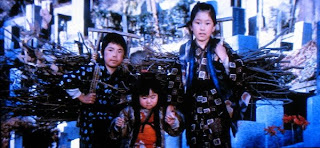
Superargo And The Faceless Giants
Fullscreen, dubbed into English
aka Il Re Dei Criminali, L'Invincibile Superman, Superargo
Director “Paul Maxwell”/Paolo Bianchini Writer Julio Buchs
Cast “Ken Wood”/Giovanni Cianfriglia (Superargo), Guy Madison (Professor Wendland), “Liz Barrett”/Luisa Baratto (Gloria Devon), Diana Lorys
 Like the
Like the
 Superargo was just one of many comic characters brought to the big screen, first in Superargo vs Diabolicus in 1966, and this, its 1968 sequel Superargo And The Faceless Giants. Played by “Ken Wood” aka Giovanni Cianfriglia, a stunt man and bit player in peplum and spy features who graduated to headlining spaghetti westerns, Superargo cuts an impressive figure: a red body stockinged superhero with a perfectly drawn square jaw and comic book eyes staring out from a black leather mask (is that masquerade or bondage chic?). In fact he’s almost identical to the all-black Diabolik, but then the Euro superheroes (Flashman, Argoman, Goldface, Phenomenal) are all just one differently-coloured mask away from melding into a huge amorphous ultrahero.
Superargo was just one of many comic characters brought to the big screen, first in Superargo vs Diabolicus in 1966, and this, its 1968 sequel Superargo And The Faceless Giants. Played by “Ken Wood” aka Giovanni Cianfriglia, a stunt man and bit player in peplum and spy features who graduated to headlining spaghetti westerns, Superargo cuts an impressive figure: a red body stockinged superhero with a perfectly drawn square jaw and comic book eyes staring out from a black leather mask (is that masquerade or bondage chic?). In fact he’s almost identical to the all-black Diabolik, but then the Euro superheroes (Flashman, Argoman, Goldface, Phenomenal) are all just one differently-coloured mask away from melding into a huge amorphous ultrahero.
 In Superargo And The Faceless Giants, Ken Wood makes his first appearance in a wrestling ring, and you’d be forgiven for thinking this was yet another Santo knockoff from
In Superargo And The Faceless Giants, Ken Wood makes his first appearance in a wrestling ring, and you’d be forgiven for thinking this was yet another Santo knockoff from
 He's called in as a freelance agent for the secret service to investigate the case of the missing champions: all world class athletes kidnapped by the clearly insane Professor Wendland and somehow replaced by the titular “faceless giants” – tallish (but not excessively so) robots with pantyhose features and Cybermen cutoffs. His sidekick Claire is also nabbed and brainwashed by the mad Professor into destroying Superargo and thus taking over the world. In the words of Kurt Vonnegut: and so it goes. You've seen it a thousand times before in a thousand configurations, and still it's as much goofy fun as watching Batman as a kid for the very first time.
He's called in as a freelance agent for the secret service to investigate the case of the missing champions: all world class athletes kidnapped by the clearly insane Professor Wendland and somehow replaced by the titular “faceless giants” – tallish (but not excessively so) robots with pantyhose features and Cybermen cutoffs. His sidekick Claire is also nabbed and brainwashed by the mad Professor into destroying Superargo and thus taking over the world. In the words of Kurt Vonnegut: and so it goes. You've seen it a thousand times before in a thousand configurations, and still it's as much goofy fun as watching Batman as a kid for the very first time.
Batman’s Euro counterparts may have less kitsch and more quiche at their disposal, but it's no less insane, and with its mutant surfadelia and wrestlemania in full swing, I'm sure you're going to go Batshit crazy over Superargo And The Faceless Giants. (Andrew Leavold)








































